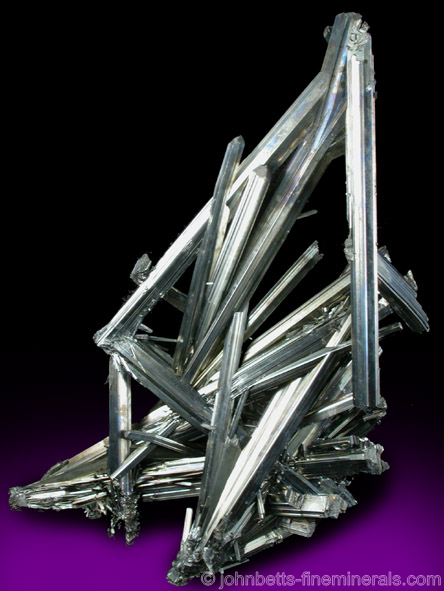The Mineral stibnite

Stibnite is named after the latin stibium, which is the old name
of the element antimony (Sb). Stibnite was and continues to be the primary ore of antimony. Stibnite forms some of the most outstanding natural crystals that
exist, in way of sharpness, luster, and size. It can form in groups of
huge metallic lustered crystals that are elegantly crafted and
exceptionally shiny.
Stibnite is often replaced by dull
yellow Stibiconite and Cervantite. The pseudomorph is
sometimes only partial, in which only a section of the crystal has been
altered, with the rest remaining intact. Stibnite may occasionally tarnish with a dull or iridescent coating.
Color
Metallic silver-gray. Occasionally iridescent with mild play of colors.
Crystal System
Orthorhombic
Properties
Streak
Dark gray |
Hardness
2 |
Transparency
Opaque |
Specific Gravity
4.6 |
Luster
Metallic |
Cleavage
None |
Fracture
Uneven |
Tenacity
Brittle. Very slightly sectile. |
Crystal Habits
In long and slender prismatic crystals, often densely grouped at different angles or in starburst aggregates. Single crystals, which can be quite large in a few localities, can resemble swords. Terminated crystals have pyramidal or flattened, slightly pointed terminations. May also be in thin fragile needles, reticulated, radiating, grainy, massive, encrusting, reticulated, and capillary. Crystals are deeply striated vertically, and may also be bent, curved, or warped.
Uses
Stibnite is the most important ore of the element antimony, and is an industrially important mineral. It was used as a metallic cosmetic in ancient civilization. Stibnite also forms some of the most exceptional crystal formations of all minerals, and large and well crystallized are highly sought after and appreciated by mineral collectors.
Noteworthy Localities
A classic locality for Stibnite is the now-exhausted Ichinokawa mine, on Shikoku Island, Japan, famous for producing outstanding large crystals and groupings. The Chinese occurrences have become the latest producers of the most exceptional Stibnite specimens, with some of them producing crystals enormous in size. The most important Chinese deposit, as well as the world's largest antimony mine, is the Xikuangshan Mine, Lengshuijiang, Loudi Prefecture, Hunan Province. Other important Chinese localities include the Wuning Mine, Qingjiang, Jiangxi Province; Qinglong, Guizhou Province; the Dahegou Mine, Lushi, Henan Province; and Nandan, Hechi Prefecture.
Romania has produced classic and aesthetic examples of Stibnite. Specific localities include Baia Sprie; Baia Mare (especially the Herja Mine); and Kapnik all in Maramures Co. Also in Maramures is the locality of Baiut, which produced groupings of unusually thick crystals. Other European Stibnite localities include Příbram, Bohemia, Czech Republic; Stadtschlaining, near Oberwart, Austria; Wolfsberg, Harz Mountains, Germany; and Manciano, Tuscany, Italy.
In South America, there are several good localities in Peru, including Quiruvilca, La Libertad Dept; the Palomo Mine, Huancavelica Dept; and Raura, Lima Dept. Another important South American locality is the Socavón Mine, Oruro, Bolivia. In Mexico, a noted occurrence is San Martín, Zacatecas.
In the U.S., the best-known Stibnite is from the White Caps Mine, Manhattan District, Nye Co., Nevada. Other localities include the Murray mine, Independence Mountains, Elko Co., Nevada; the Stayton District, Hollister, Diablo Range, San Benito Co., California; the McLaughlin Mine, Knoxville, Napa Co., California; and the Red Devil Mine, Bethel Borough, Alaska.